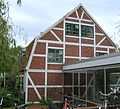Hinschenfelde
Hinschenfelde is a residential area in the Hamburg district of Wandsbek . Originally a farming village on the north bank of the Wandse , it was transformed in the 19th century into an industrial suburb of the then still independent city of Wandsbek.
history
Hinschenfelde was first mentioned in a document in 1336. At that time it belonged to the Strus family. In 1646, the noble estate Wandsbek acquired the village. The painter David Kindt owned a house there in the 17th century . After the estate was divided in 1807, Hinschenfelde came to the royal share and became an independent rural community.
In 1817 the first school was founded in the village, which was also responsible for the neighboring Tonndorf . With the annexation of Schleswig-Holstein , Hinschenfelde became part of the newly founded Stormarn district . The introduction of the Prussian municipal constitution in 1899 led to the formation of the Hinschenfelde district, to which the municipality of Tonndorf-Lohe also belonged. With the settlement of tanneries , leather factories , calico printing works and brickworks , Hinschenfelde changed from a farming village to an industrial location in the course of the 19th century.
In 1900 Hinschenfelde was incorporated into Wandsbek , with which it came to Hamburg in 1937 due to the Greater Hamburg Act . As early as 1910, the garden city of Wandsbek was built in the north of Hinschenfelde . Today's Wandsbek-Gartenstadt underground station was called the Hinschenfelde underground station from its opening in 1918 to 1920 .
Buildings
Oil mill
The oil mill is one of the last two existing mill buildings on the Wandse next to the Eichtalpark restaurant . The building has been attested since 1747. The building was used commercially until the 1960s. In 1971, like the neighboring mansion from the first half of the 19th century, it was converted into a student residence.
Former cigarette factory " Haus Neuerburg ", east wing (built in 1924)
Villa Martens
The Villa Martens is one of the last two remaining farm villas in Hinschenfelde. Built in 1909, it housed generations of the Martens family, among other things, a pub (before the Second World War ) and from 1943 to 1955 a branch of the Hamburger Sparkasse. Listed under monument protection in 1999, the villa was extensively restored in 2002 and is now used as a residential building again.
Churches
After Hinschenfeldes incorporated into Wandsbek, it got its own church, the Kreuzkirche , in 1909/10 . The architect was Fernando Lorenzen , who also designed the destroyed Christ Church in Wandsbek .
In 1965, the Emmaus Church was inaugurated next to the Hinschenfeld cemetery. It is the only church that officially bears the name Hinschenfelde: Ev.-luth. Emmaus parish of Hinschenfelde
park
The Eichtalpark opened in 1926 along the Wandse .
literature
- Helmuth Fricke: Hinschenfelde. Mosaic of a forgotten town. Verlag Media-Service Axel Juckenack, Hamburg 2013, ISBN 978-3-00-043531-7 .








